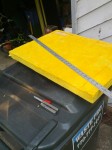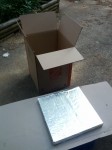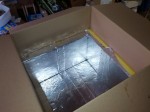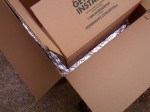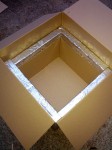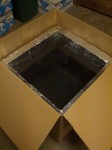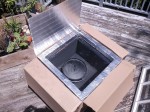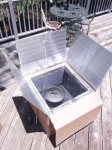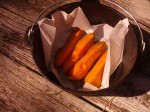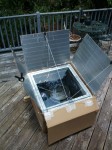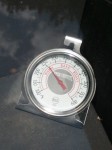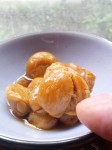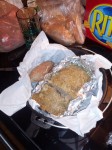 I have been doing a lot of reading on cooking with solar. Having played with the dish a few years ago, I know and believe that there is massive untapped power in the sun. I know that I am not saying anything new. Anyone with a solar lamp on their sidewalk knows that we can make some form of altered energy from the sun. Sure you probably have seen roofs full of panels making electricity to power washing machines and air conditioners. But conversion of light to electricity is not by any means the most efficient use of solar. Heat is the natural conversion of choice here folks.
I have been doing a lot of reading on cooking with solar. Having played with the dish a few years ago, I know and believe that there is massive untapped power in the sun. I know that I am not saying anything new. Anyone with a solar lamp on their sidewalk knows that we can make some form of altered energy from the sun. Sure you probably have seen roofs full of panels making electricity to power washing machines and air conditioners. But conversion of light to electricity is not by any means the most efficient use of solar. Heat is the natural conversion of choice here folks.
I have been reading about the idea, that with nothing more than a couple of cardboard boxes, some aluminum foil, and a plate of glass, one can cook whole meals. The theory is that with 2 cardboard boxes (one inside the other), with some sort of insulation placed in between, it can trap heat rather well. The insulation can be as simple as crunched up newspaper. The inside walls are painted black to absorb as much of the light as possible. The walls then acts as a heat radiator. Placing a piece of glass over the top allows light in, the light hits the black surfaces and heats (sends infrared radiation) back out all directions. The aluminum foil and glass reflect the infrared radiation back into the box, so the effect is accumulative. In my investigation of this, I have seen stories of solar ovens reaching 360 degrees. That would make a fully capable solar oven. Clearly… This was something I had to try.
 For some reason, I am prone to overkill. Using newspaper made sense, but I had some left over 2 inch thick fiberglass insulation from when I was making the sound panels for the studio. This stuff should do a wicked job in holding the heat. After measuring and cutting the fiberglass, I covered it with heavy duty aluminum foil. This was held in place with a liberal coating of 3M Spray 90. I placed the covered fiberglass pieces into the first box making a second box. I then placed a second cardboard box inside this and cut it to size. Clear as mud? Right then… The inside of the second cardboard box was then spray painted with rustoleum high heat black. I used strips of aluminum tape on the box flaps for reflectors.
For some reason, I am prone to overkill. Using newspaper made sense, but I had some left over 2 inch thick fiberglass insulation from when I was making the sound panels for the studio. This stuff should do a wicked job in holding the heat. After measuring and cutting the fiberglass, I covered it with heavy duty aluminum foil. This was held in place with a liberal coating of 3M Spray 90. I placed the covered fiberglass pieces into the first box making a second box. I then placed a second cardboard box inside this and cut it to size. Clear as mud? Right then… The inside of the second cardboard box was then spray painted with rustoleum high heat black. I used strips of aluminum tape on the box flaps for reflectors.
In my reading someone made a really good point. You probably do not want to be eating food that has been sitting in spray paint gassed air. As the oven is heated, the paint will gas off. This is also true of the spray 90 as well as all the other ‘man made’ materials (fiberglass and cardboard). So the suggestion was to ‘run’ the oven, without food, to get as much of the bad stuff out as possible. I decided to do a test run. I used only 1 reflector for the test. I put quart of water in a Dutch oven and placed it in the solar oven at 11:40 am. Using my wireless oven thermometer, the water was 76 degrees. The water temperature went up 42 degrees (118 measured) by 12:40 pm. It then got quite cloudy, but even with the clouds it went up another 19 degrees (137 measured) by 1:40 pm. It then got much more overcast. I decided to let it go through the afternoon, but was going to pull it if it started to rain as cardboard and water don’t coexist so well. At 2:40 it was up another 10 degrees for 147 degrees. At 3:10 I pulled it inside because it started to rain. It was 155 degrees at this point for a total accumulation of 79 degrees.
For reference, water is pasteurized 160 degrees, and can start cooking food once it gets above 145 degrees and real baking starting around 180. While I did not reach this on the previous run, it was a great proof of concept. The following weekend, I decided to try to actually cook something. I wanted to try something really dense, so I chose a sweet potato. I sliced it into 4 quarters. I lightly coated it with olive oil and sprinkled it with some sea salt. This time I put a standard oven thermometer in the oven area and the wireless in with the food again. This way I could see the relation between the oven and the food temps. I used all 3 reflectors for this run. I read one thread that made the suggestion to ‘preheat’ the oven. So I put it out at 11:10am. It was 76 degrees outside.
Temperature Change
| Time | Oven Temp | Internal Temp | Increase |
|---|---|---|---|
| 11:10am | 76 | 70 | N/A |
| 11:50pm | 148 | 75 | 20 |
| 12:50pm | 200 | 156 | 86 |
| 2:00pm | 225 | 202 | 132 |
| 2:50pm | 225 | 210 | 140 |
 This was roughly where it stayed for the rest of the afternoon. The internal reached a high of 210 at 2:50. Probably being way too cautious, I waited until 5pm to pull the food. I generally feel like a pretty intelligent person. But I will admit, I have the occasional lapse of seeing the reality of the situation. There is a reason why an oven is called an oven. Just because it is solar does not make it not believable nor powerful. Even though I saw the temperature, I assumed that it would not be that hot. Well, it was. I lifted the glass and was met with a wave of wicked hot air (clue number 1 numb nuts!). I reached in and grabbed the lid of the Dutch oven. Mmmmyeahhh. Lets just say that the lid was put back rather quickly. This was so impressive and so much more confirmation of just how powerful solar can be. I ran in the house, grabbed my cell phone, and recorded one of those videos I swore I would never do. You know the one… the shaky, point of view horror shows called “I just gotta show you this thing I’m doing”. But hey, I was excited. After this, I felt I was ready for an official meal with the thing.
This was roughly where it stayed for the rest of the afternoon. The internal reached a high of 210 at 2:50. Probably being way too cautious, I waited until 5pm to pull the food. I generally feel like a pretty intelligent person. But I will admit, I have the occasional lapse of seeing the reality of the situation. There is a reason why an oven is called an oven. Just because it is solar does not make it not believable nor powerful. Even though I saw the temperature, I assumed that it would not be that hot. Well, it was. I lifted the glass and was met with a wave of wicked hot air (clue number 1 numb nuts!). I reached in and grabbed the lid of the Dutch oven. Mmmmyeahhh. Lets just say that the lid was put back rather quickly. This was so impressive and so much more confirmation of just how powerful solar can be. I ran in the house, grabbed my cell phone, and recorded one of those videos I swore I would never do. You know the one… the shaky, point of view horror shows called “I just gotta show you this thing I’m doing”. But hey, I was excited. After this, I felt I was ready for an official meal with the thing.
 The following weekend I decided to make a meatloaf. While I have gained a full respect of the oven, I am still not ready to try chicken yet, but I figured that meatloaf was pretty safe. I wanted to push the idea, so I made a 2+ pound load, plus 3 sweet potatoes. I also wanted to make some roasted garlic, but I did not want it interfering with the meatloaf, so made a separate cooking vessel. I painted a spaghetti sauce jar black (the outside). I lightly coated the garlic with olive oil, and put them into the jar. I did puncture the top of the jar so it would not blow up. I also added a few pieces of string so the reflective flaps would stay put. They flopped around a bit in the wind on the previous test. Once again the oven temperature took off like crazy and stayed nice and hot all day. My wife was sleeping through the day as she needed to work that night. One of the things I have been reading is that the food will not burn, and will stay quite moist regardless of how long it sat. I put the food in the oven about 12pm. While I was watching both temps, for food safety, my primary concern was the temperature of the meat, so the wireless oven probe was placed inside the meatloaf. I was shocked, at 2:40 pm the meatloaf was completely done. It was sitting at a comfortable 170+ degrees. I let it cook until my wife was up and ready for some food.
The following weekend I decided to make a meatloaf. While I have gained a full respect of the oven, I am still not ready to try chicken yet, but I figured that meatloaf was pretty safe. I wanted to push the idea, so I made a 2+ pound load, plus 3 sweet potatoes. I also wanted to make some roasted garlic, but I did not want it interfering with the meatloaf, so made a separate cooking vessel. I painted a spaghetti sauce jar black (the outside). I lightly coated the garlic with olive oil, and put them into the jar. I did puncture the top of the jar so it would not blow up. I also added a few pieces of string so the reflective flaps would stay put. They flopped around a bit in the wind on the previous test. Once again the oven temperature took off like crazy and stayed nice and hot all day. My wife was sleeping through the day as she needed to work that night. One of the things I have been reading is that the food will not burn, and will stay quite moist regardless of how long it sat. I put the food in the oven about 12pm. While I was watching both temps, for food safety, my primary concern was the temperature of the meat, so the wireless oven probe was placed inside the meatloaf. I was shocked, at 2:40 pm the meatloaf was completely done. It was sitting at a comfortable 170+ degrees. I let it cook until my wife was up and ready for some food.
 Being smarter about my food removal, I used some hot pan holders this time… heh heh. When I walked outside I could smell the roasted garlic. It was really intense. I lifted off the top glass and again was hit with a wave of hot air, but this time it was a wave of hot really really GOOD smelling air. I took everything inside and cut into the loaf. It sliced like butter. I am not sure that meat should slice like butter, but it was tender for sure. The only thing I want to sort out is how to brown the food. The flavor was amazing. I have a theory about why too. See… The Dutch oven is a small tight space, so the flavors have no where to go. Being somewhat bored, the flavors seek out the meat and attack it. Several hours later, they are so dizzy drunk with meaty goodness, they have no desire to leave. It is at this point that we want to eat it, and there is no time for escape… yeah… well. perhaps not.
Being smarter about my food removal, I used some hot pan holders this time… heh heh. When I walked outside I could smell the roasted garlic. It was really intense. I lifted off the top glass and again was hit with a wave of hot air, but this time it was a wave of hot really really GOOD smelling air. I took everything inside and cut into the loaf. It sliced like butter. I am not sure that meat should slice like butter, but it was tender for sure. The only thing I want to sort out is how to brown the food. The flavor was amazing. I have a theory about why too. See… The Dutch oven is a small tight space, so the flavors have no where to go. Being somewhat bored, the flavors seek out the meat and attack it. Several hours later, they are so dizzy drunk with meaty goodness, they have no desire to leave. It is at this point that we want to eat it, and there is no time for escape… yeah… well. perhaps not.

